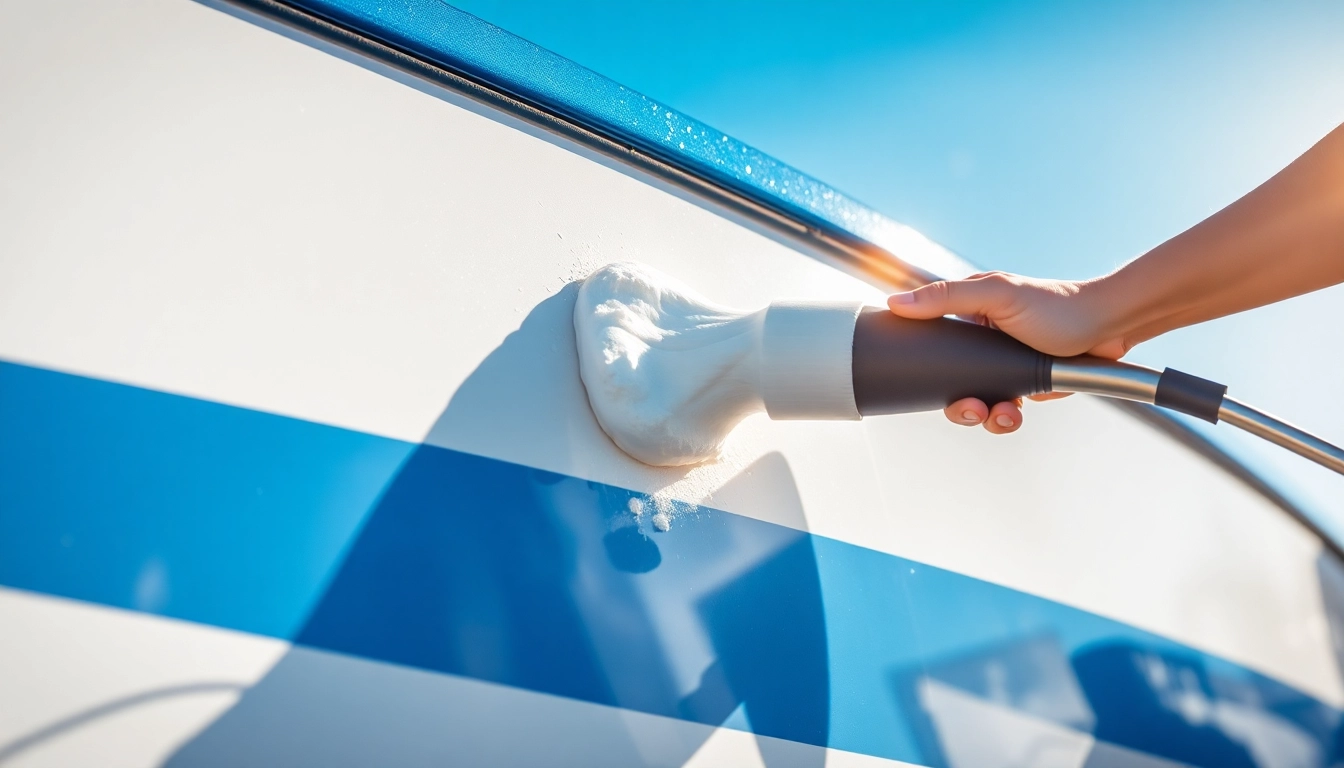Understanding Boots Versiegelung: Benefits and Features
What is Boots Versiegelung and Why Use It?
Boots Versiegelung, or boat sealant, is a specially formulated protective coating designed to safeguard watercraft surfaces against environmental hazards, wear, and aging. It serves as an ultra-thin barrier that shields gelcoat, painted surfaces, and other materials on boats from UV rays, saltwater, dirt, algae, and mechanical damage. Applying a high-quality Boots Versiegelung ensures long-lasting gloss retention, minimizes maintenance efforts, and extends the lifespan of the vessel’s exterior.
In the competitive market of marine care products, using a Boots Versiegelung is considered a best practice to maintain optimal appearance and structural integrity. Not only does it enhance aesthetic appeal with a brilliant shine, but it also provides a robust defense against harsh environmental conditions, making it a vital component of a comprehensive boat care routine.
Types of Boots Versiegelung for Different Surfaces
Choosing the right type of Boots Versiegelung depends largely on the surface material and use-case scenarios. Common variants include:
- Polymer-Based Sealants: These offer excellent chemical resistance and durability, ideal for gelcoat and painted surfaces. They form a protective coating that is resistant to UV damage and water ingress.
- Ceramic Coatings: Featuring advanced nanotechnology, ceramic coatings create a hard, semi-permanent layer that provides superior UV protection, high gloss, and easy cleaning properties.
- Liquid Waxes and Cream Sealants: Easier to apply for recreational boat owners, these products enhance shine temporarily but still offer significant environmental protection.
For different surfaces such as fiberglass, gelcoat, or painted metal, manufacturers provide tailored formulations ensuring optimal adhesion and protection. Proper surface preparation before application is essential to maximize the effectiveness of each type.
Advantages Over Traditional Protectants
Compared to conventional waxes or simple cleaning products, Boots Versiegelung offers a multitude of advantages:
- Enhanced Durability: Sealants last longer, often up to a year or more depending on conditions, reducing frequent reapplication.
- Superior Resistance: They provide better protection against UV radiation, salt, pollutants, and physical abrasions.
- Ease of Maintenance: With a smooth, hydrophobic surface, dirt and water slide off more easily, lowering cleaning effort and costs.
- Consistent Gloss and Finish: The protective layer maintains a high-gloss appearance that withstands weathering.
Ultimately, Boots Versiegelung translates into economic benefits by prolonging the life of your boat’s facade and reducing the need for costly repairs or resurfacing.
Preparing Your Boat for Perfect Boots Versiegelung Application
Cleaning and Surface Preparation
Preparation is critical for optimal sealant application. Dirt, algae, and old residues can compromise adhesion and reduce protection quality. Start by thoroughly washing the boat with a dedicated boat cleaner such as the BCC Power Cleaner 1L, which effectively removes grease, salt, and marine grime. Use a soft brush or microfiber cloth to avoid scratching the surface.
Follow up with a decontamination process like clay bar treatment if necessary, especially on heavily contaminated gelcoats. Inspect surfaces for cracks or damages and repair them prior to sealing. Proper surface dryness and cleanliness ensure the sealant bonds strongly and provides long-lasting protection.
Tools and Materials Needed for Optimal Results
For professional results, gather appropriate tools and materials, including:
- High-quality microfiber towels (e.g., BCC Microfaser Towel 3er Pack) for wiping and buffing
- Application pads or foam applicators for even layer distribution
- Surface polish or cleaner to prepare the surface (if necessary)
- Protective gloves and masks for safety during application
- Cleaning sprayers like the GLORIA FoamMaster FM 10 for foam application, especially when using foam-based sealants
Using the right tools helps in achieving a uniform, streak-free coating, which enhances both appearance and protection.
Environmental Conditions for Installation
Choose a calm, dry day with temperatures ideally between 15°C and 25°C. Avoid applying Boots Versiegelung in direct sunlight, as rapid drying can cause streaks or poor adhesion. Humidity levels should be moderate; high humidity can impair curing, while very low humidity can slow down the process.
Ensure good ventilation if working indoors or in enclosed spaces, and keep the surface free from dust and contaminants during application for optimal results.
Step-by-Step Guide to Applying Boots Versiegelung
Applying the First Coat Correctly
After surface preparation, shake the Boots Versiegelung container well. Use a foam applicator or microfiber pad to apply a thin, even layer across a manageable section. Work in small areas, overlapping each pass to prevent missed spots. Follow the manufacturer’s recommended drying time, typically around 10-15 minutes, before curing.
Techniques for Achieving a Smooth, Even Layer
Buff the applied coating with a clean, dry microfiber towel in circular motions to remove excess product and achieve a glossy finish. Maintain consistent pressure and avoid pressing too hard to prevent streaks. For large surfaces, use a two-cloth technique: one for application and another for buffing. Proper technique ensures a smooth, uniform appearance that maximizes protection.
Drying and Curing Times for Long-Lasting Protection
Most Boots Versiegelung products require about 24 hours to cure fully, during which the surface should remain dry and undisturbed. Avoid exposure to water or extreme environmental conditions until curing is complete. This ensures the protective layer develops its full bonding strength, offering optimal resistance against environmental threats.
Maintaining and Reapplying Boots Versiegelung
Regular Inspection and Cleaning Tips
Regularly inspect your boat’s surface for signs of wear, such as dullness, water spots, or dirt buildup. Use gentle cleaning methods with microfiber towels and mild marine-safe cleaners to maintain the integrity of the sealant. Avoid abrasive scrubbers that could damage the protective layer.
When and How to Reapply for Best Results
Reapplication intervals depend on usage and environmental exposure. Typically, a thorough cleaning followed by a new coat every 12 to 24 months is recommended for maximum efficacy. Carefully remove any old, degraded layers with a polishing compound before reapplying the sealant to ensure proper adhesion.
Common Mistakes to Avoid During Maintenance
Common errors include applying sealant on dirty or wet surfaces, over-application, or neglecting proper curing times. These mistakes can lead to streaks, poor adhesion, or reduced protection. Always follow manufacturer instructions and conduct spot tests to verify compatibility.
Performance Metrics and Choosing the Right Boots Versiegelung
Indicators of Effective Protection
Look for clarity and gloss retention, water beading behavior, and resistance to fingerprints and dirt. A good Boots Versiegelung should repel water effectively, cause water to bead and roll off, and maintain its appearance for an extended period.
Performance Comparison of Various Products
When evaluating options, consider factors like lifespan, ease of application, and environmental resistance. Products incorporating nanotechnology and advanced polymers, such as Gtechniq Marine Ceramic Top Coat, tend to outperform traditional sealants in durability and hydrophobic properties.
Expert Recommendations and User Testimonials
Experts agree that proper surface preparation combined with a high-quality sealant ensures the best protection. Many users have reported reduced maintenance efforts and long-term satisfaction using tailored marine sealants. Reading reviews and case studies can inform your choice, ensuring you select a product aligned with your boat type and usage conditions.

